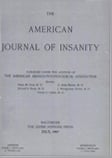Abstract
1. In 428 cases of neurosyphilis treated during a period of four years, 129 cases or practically 30 per cent showed definite benefit. 125 cases are under treatment in hospitals of which a certain percentage can be expected to show similar improvement. Among 93 cases that have drifted away, another definite proportion, probably a larger number comparatively can be presumed to have benefited from treatment.
2. There are two definite groups of cases of neurosyphilis;the early or "psychopathic hospital" group and the advanced committable or "custodial group." The early case of the "psychopathic" type is not met with in insane hospitals—except in such as conduct out-patient departments. These cases also frequently first come to professional attention through the field of general or "internal" medicine.
3. The relatives (spouses, parents, offspring) of syphilitics and neurosyphilitics form a most important group in which not only syphilis but the earliest degrees of neurosyphilis, in the presymptomatic, often entirely unsuspected, stages, are brought to light by lumbar puncture and sero-analysis. It is in these types that by far the most benefit can be expected.
4. Early diagnosis preferable before pronounced mental symptoms have appeared gives the greatest promise of successful results. For it seems that for some reason, probably of a psysio-logico-chemical character, the curative agent is less able or practically unable to influence certain bacterial toxins after they have had time to combine with the neuroplasm. Another instance of this phenomenon is shown in the case of the tetanus toxin.
5. Apparently advanced neurosyphilis is not a contra-indication to treatment—there is a distinct, though not large—percentage of such cases that amply gratify the efforts of intensive attack.
6. In early and atypical cases the most exhaustive, and often, repeated, serological and spinal fluid examinations are the best guides to the diagnosis. The provocative method should not be overlooked.
7. Intensive and prolonged treatment to the point of saturation with the combined force of the three specifics, arsenic, mercury and potassium iodide. Arsphenamin has been preferred to neoarsphenamin as more lasting in its effects.
8. The therapia praesens of neurosyphilis is but a transition state in rational syphilotherapy. Medical science has discovered several good clues which must be followed up; and others ferreted out and run down before the solution of the problem is complete. Indeed the successful treatment of paresis and tabes as well as general vascular syphilis and visceral tertiaries such as the crippling cradio-pathia, etc., may ultimately be realized in the field of preventive medicine. With chemotherapy, however, Ehrlich has doubtless found the most vulnerable approach to the treponemiatic diseases, but further research is necessary and other combinations must be found before the life of this anthropophagous pest is successfully snuffed out.

